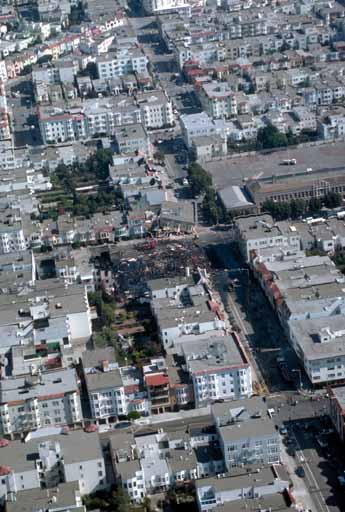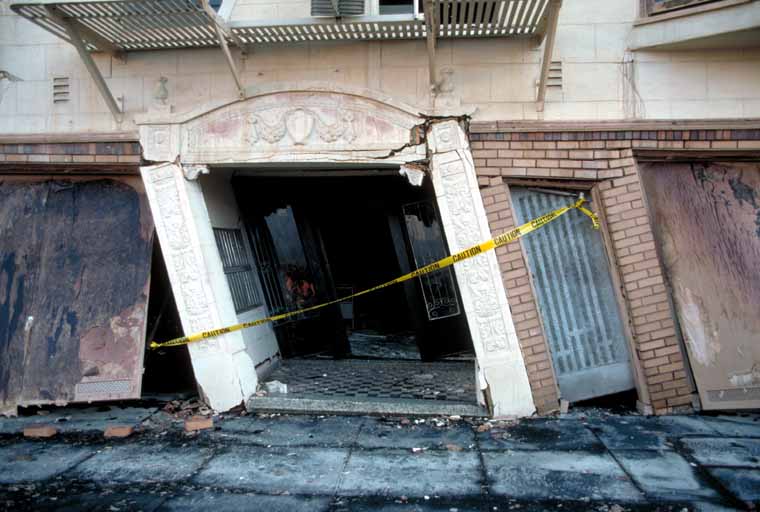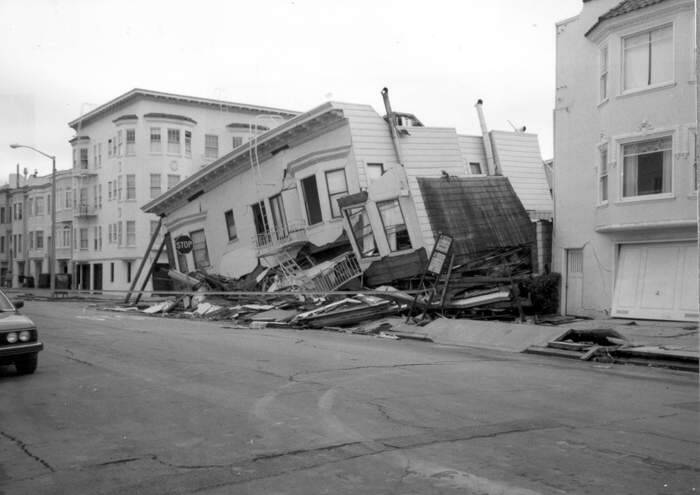Remembering SF's 1989 Earthquake
"I was there..."
by Michael Whitson
October 17 is a very special as well as somewhat enigmatic date in my personal history. My father at age forty-nine unexpectedly died of a heart attack on that date in 1969 when I was only fourteen years old. Coincidentally, twenty-nine years later I received a successful heart transplant at age forty-three on October 17. In between those two occasions San Francisco, where I lived for thirty years of my adult life, experienced its own memorable event on October 17, 1989.
Entrance and garage level of a Beach Street apartment complex in danger of collapse, Marina District.
Photo: C.E. Meyer, U.S. Geological Survey
A magnitude 7.1 earthquake hit the San Francisco Bay Area, killing 67 people, injuring 3,757, leaving more than 12,000 homeless, and causing more than $5 billion in damages. Despite the fact it was one of the most powerful and destructive quakes ever to hit a populated area of the United States, the death toll was fortunately relatively small. At least 27 fires broke out across the City, including a major blaze in the Marina District where apartment buildings sank into a lagoon filled with bay mud in preparation for the Panama-Pacific International Exposition of 1915. Dozens of people were rescued by firefighters from fallen buildings in the area that were imperiled by the flames. As they also had done in 1906, SF citizens formed a bucket brigade to help firefighters who were without water because of broken mains.

That day I arrived home from work a few minutes before 5pm as had my next door neighbor Chris Martin. We were both musicians who had self-employed day jobs working in the trades. We traded minor gripes about our work day and digressed into talking about music as we walked up an exterior flight of steps onto the stoop outside my front door at 1668 Page St. in the Haight Ashbury district of San Francisco. It was a warm October evening and we lingered for a few minutes chatting ... and then everything started going very, very strange. My first thought was, "I'm feeling kinda dizzy." And then, "No, it is actually the world around me that is going quite dizzy." Chris shook me out of my shock and temporary stupor when he started yelling, "OH SHIT! It's an earthquake!!!"
Without thinking or talking, we both impulsively ran down the steps and out into the middle of the street which at that moment was devoid of car traffic. In retrospect, this immediately did not seem like the wisest response as the power lines above us were wildly swinging and repeatedly arcing and crackling as they collided with one another. Down the street at the corner of Page and Ashbury I could see a three story brick chimney collapsing and burying a parked car below it. I looked up and saw all the physically touching side-by-side three story Victorian houses that filled our block boldly swaying back and forth together as if they were one organism. Strangely, the fact they now oddly appeared connected and perhaps about to crash as one entity was my most unnerving impression. Occasionally, a window would pop out or crack especially those on the third stories. None of this inspired much confidence in our spontaneous decision to run out into the middle of the street. But what to do now? My friend Chris was clutching my waist in a Vulcan vice grip and crying/bellowing like a moose. Later, I discovered his grip was so intense that I would have purple welts on my stomach for a week where his fingers had dug in.
Even though the quake lasted probably only 25 seconds or so where we were ... it seemed like it would never end. It was one of those situations in which the normal experience of time is completely disrupted. It was quite eerie to feel time suspended in a cinematic way as if altered by slow motion effects. There was the felt experience that time now had become elastic and elongated. There also was a bizarre kinesthetic sensation that this was some sort of giant earth orgasm. First, there was a steady build up of tectonic trembling. Then a middle period of heightened intensity and convulsing. And finally a slow dissipation back to stasis. As it was happening though I was overwhelmed by the uncertainty of wondering whether this quake was ever going to stop? Or will it just keep getting worse and worse? (Have you ever been in situation at an apartment complex or hotel in which you can hear the sounds of others having sex? But you would rather be sleeping or at least not having to hear their interminable sonic provocations. Yet it is impossible not to. And then you start to root for them to finally work it out and be done with it all, thank you very much! Well, it was a little like that: "Earthquake, could you please just bloody well finish up and leave me in peace? ")
I had never experienced anything remotely close to this. The several quakes experienced in three decades of living in SF were, for the most part, over by the time I realized they were occurring. But not this time. It was quite peculiar. As the earthquake was happening I was consumed by fear. But once it ended that troubling angst promptly turned on a dime into elation. Not only was the world (and/or my life) not about to abruptly end but even better 'normal' life was now temporarily cracked wide open. No electricity. No phones. Within hours the mayor announced over the radio, "Except for emergency workers, no one should go to work tomorrow." Now, that is my kind of orders by a mayor in the rare service of capsizing normality.
Once I collected my senses I decided to get on my bike and ride around the city to take it all in. I had a lot of adrenaline so I began pedaling rapidly. It felt invigorating to just feel the wind in my face as I rode down from the top Buena Vista Park into the Castro. Eventually, I wandered down 18th St. into the Mission. It was the intersection of 18th and Dolores that I made my first stop and got off my bike. I had to because I was laughing so hard I couldn't ride anymore. There in the middle of the street was what appeared to be a Fidel Castro doppelganger directing traffic. Dressed in faux Cuban military fatigues, the trademark 'Fidel' cap, army boots, and a full beard was a man who possessed a striking resemblance to Castro. I initially thought it was a tongue-in-cheek prank. But then as he demonstrably and effectively directed traffic, I realized this was instead an act of unconscious, unintended parody. At least it was for me. But for those driving a car here was a real life cartoon character providing a vital public service. You have to remember with the electricity out, of course, traffic lights don't exist. That coupled with the collective trauma birthed by a major earthquake made car driving at busy intersections chaotic and potentially dangerous. This man's emphatic and decisive gesticulations directing cars to stop or go was extremely helpful and welcome. Outside of such a situation in a natural disaster I normally would have considered this guy an inappropriate control freak. But in this context his alpha, authoritative guidance generated immediate civic benefit. It was absolutely true even though I was pissing my pants laughing at his quixotic performance presentation.
Damaged structures, Marina District, San Francisco.
I had long forgotten that memory until I recently read William James account of the aftermath of SF's 1906 earthquake. He wrote an essay entitled: "On Some Mental Effects of the Earthquake", that was published on June 7, 1906 in the journal Youth's Companion. One passage by James, in particular, spoke directly to what I experienced some 83 years later at the intersection of 18th and Dolores:
"Two things in retrospect strike me especially, and are the most emphatic of all my impressions. Both are reassuring as to human nature. The first of these was the rapidity of the improvisation of order out of chaos. It is clear that just as in every thousand human beings there will be statistically so many artists, so many athletes, so many thinkers, and so many potentially good soldiers, so there will be so many potential organizers in times of emergency. In point of fact, not only in the great city, but in the outlying towns, these natural order-makers, whether amateurs or officials, came to the front immediately." (Emphasis added.)
They certainly did again in 1989 as they also had in 1906 ... dragging hoses from the Bay to help firefighters in the Marina, directing traffic at numerous street corners (especially important after dark), showing neighbors how to turn off gas lines, walking up flights of stairs to help trapped elderly, bringing food and medical supplies to those in need, consoling complete strangers who were worried sick about loved ones, etc. This earthquake knocked out power to San Francisco, and the entire city was completely dark for the first time since the 1906 earthquake and its devastating fires. Power was not fully restored until October 20. Emergency telephone service became sporadic because a fire broke out in the 911 telephone equipment room. Thus, citizens had to rely on fire alarm boxes for three days for emergency protection from fire.
In addition to the need to improvise order out of chaos, this disaster also begat a singular, spontaneous holiday. That holiday began immediately for the vast majority of San Franciscans who were neither physically harmed nor suffered serious damage to their personal property. I realized this more fully as twilight approached. So I decided to pedal back home from Bernal Heights where I had meandered. By the time I got back to the Haight Ashbury it was completely dark. Since there was no electricity functioning anywhere in the city it was, indeed, RESOUNDINGLY DARK! Most of the stoops to the houses were flickering with candle light as I rode down my block. Many of my fellow Page St. neighbors were sitting outside in the warm evening sharing stories of their adventures that day. Many were sharing a bottle of wine as well. You could hear battery powered radios broadcasting news and accounts of the earthquake that day. Radio, in this situation, was the only form of "news" that was available beyond direct person to person exchanges. I will never forget the felt collective elation when the mayor announced on the radio that except for emergency workers, NO ONE SHOULD GO TO WORK THE NEXT DAY. This produced a ripple effect of cheers and the chinking of glasses rolling down my block. It also immediately brought up the question of what exactly one should do with this unexpected suspension of normal life? The earthquake had indeed left cracks in buildings and streets in its wake. It also had created equally big fissures within the social construction of daily life.
Since none of my neighbors went to work the next day several households on my block decided to meet. What originated as a way to try to figure out things collectively quickly became an impromptu tour to "show off" the damage within each of our houses. It was hilarious and absurd to me as this evolved into a kind of contest for bragging rights about cracked walls, broken windows and pipes, collapsed chimneys, etc. What was most remarkable was the fact that each of us were going into our neighbors houses often for the first and last time we would do so. My block had a diverse mix of aging African-American couples who owned their homes and much younger, mostly white, mostly counter cultural, mostly single people that rented and lived together cheaply in shared, group households. I was a member of the latter group and that day I went inside the homes of half a dozen African-American neighbors. It was the only time I would ever do so. It was also the only time they would visit my house as I showed off the massive crack in the cement stoop at the top of my stairs. One could peer down the the 6 inches wide and 10 foot deep jagged crack at the top of my previously solid, cement stairs. This fracture you now had to carefully step cross to enter my house.
But we all went into each others homes and shared our particular earthquake stories. I learned that every single African-American couple had moved to the neighborhood in the 1950's after World War II when the Haight Ashbury was a less desirable and cheaper neighborhood to buy a house. Almost all had started families here and were now in their 60's or 70's or older with their grown children now living outside of San Francisco. I learned that these couples universally hated the hippie invasion of the Haight Ashbury in the 1960's. Instead of 'dropping out', they really wanted their offspring to 'drop in' to a better class life than the one available to them. When I was evicted in 2013 from 1668 Page St. none of these African-American neighbors still resided there. Almost all had died and their heirs had sold these highly valued homes to mostly white professionals. As these people died and left so did their community practice of open garages in which small groups of neighborhood friends played card games, listened to sports events, and participated in similar group activities on a regular basis. It created a kind of informal, quasi public commons character in our neighborhood. A quality that was not replicated by the new residents.
What the crisis of the earthquake engendered was a shared urgency in which the usual cultural divisions, including racial alienation, were sometimes temporarily upended. This breif experience of unusual solidarity was rooted in our shared experience of surviving a disaster together. In my situation it happened to be most striking via the momentary erasure of prevailing racial alienation. But such strong (and transient) bonds of solidarity happened in literally thousands of different little ways throughout San Francisco among people from all walks of life. It was one of the unexpected benefits to arise from a time of crisis. A week later it was all gone. But that was one glorious week to live in San Francisco.


